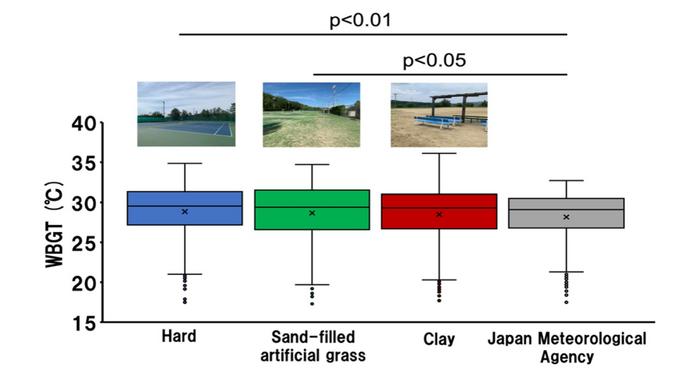With rising global temperatures due to global warming, the risk of heat strokes has increased and is expected to grow even further. This is particularly troubling for athletes participating in competitive sports. In tennis, multiple matches are played daily, lasting up to five hours. Playing such matches in sweltering conditions could be highly detrimental.

Credit:
With rising global temperatures due to global warming, the risk of heat strokes has increased and is expected to grow even further. This is particularly troubling for athletes participating in competitive sports. In tennis, multiple matches are played daily, lasting up to five hours. Playing such matches in sweltering conditions could be highly detrimental.
The Tokyo Olympic Games in 2021 faced extremely hot conditions with many players calling for appropriate countermeasures. Consequently, the International Tennis Federation (ITF) formulated and issued the “Extreme Weather Policy” at the Tokyo Olympics to manage matches based on temperature. Despite this policy, heat-related illnesses remain a major issue in Tennis.
Tennis matches are played on various court surfaces. In Japan, three types of surfaces are used: hard, sand-filled artificial grass and clay courts. Studies have shown that the total heat load on players can vary depending on the surface material, constituting diverse microclimatic environments, different from established weather stations. The wet-bulb globe temperature (WGBT), an index for measuring thermal environments, highly correlates with heat stroke and is used for environmental assessment in sporting events. While several studies have been conducted to analyze the differences in WGBT among different tennis court surfaces, they have limitations. For example, one study only conducted measurements in the afternoon, and another study failed to compare the WBGT values to those at the nearest station.
To address these issues, a team of researchers from Japan, led by PhD student Hiroki Yamaguchi from the Graduate School of Health and Sports Science at Doshisha University, along with Professor Kojiro Ishi from the Faculty of Health and Sports Science at Doshisha University, investigated the heat-environment of different tennis courts using WBGT meters. Their findings were published in Volume 14 of the journal Scientific Reports on July 05, 2024.
“Exertional heat stroke is the second most common cause of non-traumatic death in competitive athletes. As a tennis player, I have also personally experienced heat stroke during matches. Investigating heat conditions at various tennis courts can serve as a reference for exercise guidelines and playing time and can contribute to effective heat management in sports,“ explains Yamaguchi, reflecting on his motivation for the study.
The team installed WGBT meters in an outdoor hard court, a sand-filled artificial grass court, and a clay court. Measurements were taken hourly from 9 AM to 5 PM on weekdays from June 01 to September 21, 2022. The Japan Tennis Association, in its heat stroke prevention guidelines for exercise, requires the WGBT at the nearest weather station to the tournament venue to be checked every hour whenever on-site measurements are unavailable. Hence, the researchers compared their on-site measured WGBT values to those of the nearest Japan Meteorological Agency station (JMA WBGT) based on the guideline levels.
The results revealed significant differences between the JMA WBGT and the on-site WBGT values. The median on-site WGBT values for hard courts were significantly higher at the “Warning” level (ranging from 25°C to 28°C) and above, for sand-filled artificial grass courts at the “Severe Warning” level (ranging from 28°C to 31°C) and above, and for clay courts at the “Danger” level (greater than 31°C), than JMA WGBT. Notably, hard and sand-filled artificial grass courts are played in particularly hot conditions. The researchers emphasize the importance of determining the heat environment through on-site WBGT measurements on surfaces and taking proactive heat countermeasures using heat safety guidelines. Additionally, they urge organizers to reduce the frequency of matches in the afternoon and explore the possibility of holding games in the early morning, evening, and nighttime.
“The results of this research highlight the importance of on-site WBGT measurements, as well as consideration of the surface and time of the match, to protect players, coaches, referees, and spectators from heat stroke, “says Mr. Yamaguchi discussing the study’s significance. Looking ahead, he adds, “Since WGBT only measures heat risk for the environment the use of body heat balance models such as Predicted Heat Strain (PHS), aimed at quantitative measurement of heat risk, is required for developing more effective heat safety guidelines in the future.”
We hope that this study will help in creating a safer environment for athletes and will lead to improved heat countermeasures in sports.
About Hiroki Yamaguchi from Doshisha University, Japan
Hiroki Yamaguchi is currently a PhD student at the Graduate School of Health and Sports Science, Doshisha University. With extensive experience as a player, coach, and tournament organizer in tennis, his interest in the impact of surface heat differences during these activities inspired this study. His broader research interests encompass sports science, exercise physiology, heat exhaustion, and environmental physiology.
Funding information
The authors report no funding associated with the work featured in this article.
Media contact:
Organization for Research Initiatives & Development
Doshisha University
Kyotanabe, Kyoto 610-0394, JAPAN
E-mail:jt-ura@mail.doshisha.ac.jp
Journal
Scientific Reports
Method of Research
Observational study
Subject of Research
Not applicable
Article Title
Using wet‑bulb globe temperature meters to examine the effect of heat on various tennis court surfaces
Article Publication Date
5-Jul-2024
COI Statement
The authors declare that the research was conducted without any commercial or financial relationships that could
be construed to be potential conflicts of interest.



